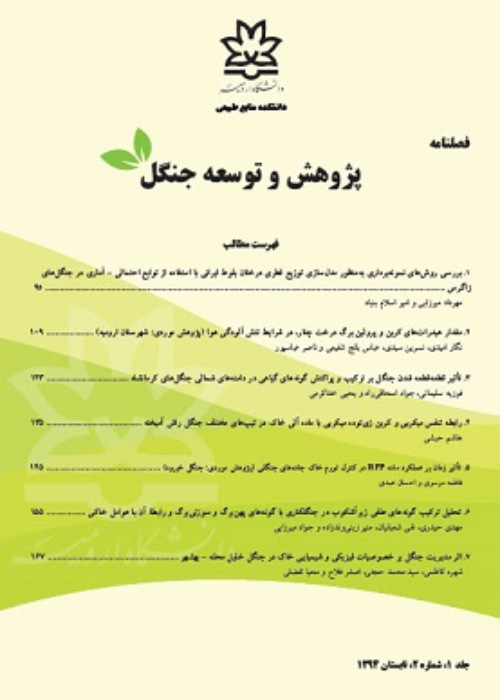The diversity indices of herbaceous species in the unmanaged and man-made forest gaps
The importance of canopy gaps in the natural forests as a part of the development processes of the stand is not hidden for ecologists. According to the gap size, different changes will be made in the microclimate of the region, which will ultimately cause the preservation and dynamics of the structure of these stands. In close to nature silviculture, while recognizing natural disturbance regimes, efforts are made to use them as a model in sustainable forest management. The purpose of applying management based on imitation is to preserve, sustain and promote species diversity. Mimicking natural disturbances has shown different effects in managed forests. In some cases, more suitable conditions have been created for the growth of seedlings and the increase of species diversity. But in some cases, management actions were either ineffective or caused negative effects. Therefore, optimal management strategies should be based on a deep assessment of forest stands, which will provide useful data in this research.
In this research, in order to determine the possible changes due to the implementation of management, the indices of diversity of herbaceous species in the gaps of a single-selection managed and a control (non-managed) beech forest were compared in district one of Livan and Banafshtape forestry projects in Golestan province. For this purpose, after identifying and measuring the surface of all gaps, in each forest, they were classified into three groups: small (less than 200 m2), medium (200 to 500 m2) and large (more than 500 m2) and Three replicates from each group were randomly analyzed. The type and percentage of cover of all herbaceous plant species were recorded in five sample plots (one in the center and the others in the four main geographical directions of each gap). Harvesting of herbaceous species of the forest floor was done using the modified Braun-Blanquet scale. To evaluate the richness of plant species in the studied habitats, the number of plant species in each sample plot was used. Biodiversity was investigated and compared in the surveyed plots using Simpson and Shannon-Weiner diversity indices and for uniformity, Paylo's evenness index was used. The comparison of the average indices between the two compartments was done using independent t and Mann-Whitney tests, and in the gaps with different sizes, Tukey and Kruskal-Wallis tests were performed. The cluster analysis method was used to group the gaps with different sizes.
In this research, 25 herbaceous species were identified in the two investigated areas. 17 and 21 herbaceous species were identified in the gaps of the managed and unmanaged plots, respectively. Some herbaceous species were present in only one of the gap size classes, but others were identified in all three gap size classes. The results showed that there is not a significant difference between the indicators of richness (7.2±0.7 vs. 8.3±0.6), evenness (0.6±0.05 vs. 0.5±0.04), Shannon (1.1±0.1 vs. 1.1±0.09) and Simpson (0.5±0.06 vs. 0.5±0.05) between the managed and unmanaged compartments, respectively. Also, the cluster analysis showed that in terms of herbaceous cover, the gaps of the managed area cannot be separated from the unmanaged area. It is interesting to note that the species richness in the managed stand with small gap size (less than 500 m2) was significantly lower than other gaps in this stand. There was no significant difference between the other investigated indicators between the different sizes of the gaps in the managed and unmanaged compartments.
The harvesting of forest trees in the form of management can change the environmental conditions such as light and temperature in the created microclimate by creating gaps that are larger or smaller than the natural size and thus cause a change in the diversity of plant species. Although the results of some researchers showed that forest management can increase the diversity of tree species compared to unmanaged forests, but in the upcoming research, the management based on the single selection method after a period of 10 years had a significant effect on the composition and there was no diversity of herbaceous cover in the created gaps. Of course, it is necessary to remember that the type of forest management can affect biodiversity on a regional scale without causing a change on a local scale. Also, the effect of forest management on plant diversity depends on biotic and abiotic conditions and forest management approaches. The results of some studies have shown that the abundance of herbaceous species in the forest floor depends on the abundance of tree species. Therefore, in a pure forest where the number of tree species is less than in a mixed forest, the low abundance of floor covering species is not far from expected. In any case, the accurate evaluation of the effects of applied management requires more studies of the floristic and soil characteristics of the gaps in different periods of time after the implementation of cuttings.
- حق عضویت دریافتی صرف حمایت از نشریات عضو و نگهداری، تکمیل و توسعه مگیران میشود.
- پرداخت حق اشتراک و دانلود مقالات اجازه بازنشر آن در سایر رسانههای چاپی و دیجیتال را به کاربر نمیدهد.


